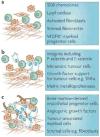The metastatic niche: adapting the foreign soil
- PMID: 19308068
- PMCID: PMC3682494
- DOI: 10.1038/nrc2621
The metastatic niche: adapting the foreign soil
Abstract
The 'seed and soil' hypothesis for metastasis sets forth the concept that a conducive microenvironment, or niche, is required for disseminating tumour cells to engraft distant sites. This Opinion presents emerging data that support this concept and outlines the potential mechanism and temporal sequence by which changes occur in tissues distant from the primary tumour. To enable improvements in the prognosis of advanced malignancy, early interventions that target both the disseminating seed and the metastatic soil are likely to be required.
Figures


Similar articles
-
Osteotropic cancers: from primary tumor to bone.Cancer Lett. 2009 Jan 18;273(2):177-93. doi: 10.1016/j.canlet.2008.05.044. Epub 2008 Jul 15. Cancer Lett. 2009. PMID: 18632203 Review.
-
Priming the 'soil' for breast cancer metastasis: the pre-metastatic niche.Breast Dis. 2006-2007;26:65-74. doi: 10.3233/bd-2007-26106. Breast Dis. 2006. PMID: 17473366 Review.
-
Preparing the "soil": the premetastatic niche.Cancer Res. 2006 Dec 1;66(23):11089-93. doi: 10.1158/0008-5472.CAN-06-2407. Cancer Res. 2006. PMID: 17145848 Free PMC article. Review.
-
Pre-metastatic niches: organ-specific homes for metastases.Nat Rev Cancer. 2017 May;17(5):302-317. doi: 10.1038/nrc.2017.6. Epub 2017 Mar 17. Nat Rev Cancer. 2017. PMID: 28303905 Review.
-
Characteristics and Significance of the Pre-metastatic Niche.Cancer Cell. 2016 Nov 14;30(5):668-681. doi: 10.1016/j.ccell.2016.09.011. Cancer Cell. 2016. PMID: 27846389 Review.
Cited by
-
Tumor-associated neutrophils (TANs) in human carcinoma-draining lymph nodes: a novel TAN compartment.Clin Transl Immunology. 2021 Feb 16;10(2):e1252. doi: 10.1002/cti2.1252. eCollection 2021. Clin Transl Immunology. 2021. PMID: 33643653 Free PMC article.
-
RUNX3 Controls a Metastatic Switch in Pancreatic Ductal Adenocarcinoma.Cell. 2015 Jun 4;161(6):1345-60. doi: 10.1016/j.cell.2015.04.048. Epub 2015 May 21. Cell. 2015. PMID: 26004068 Free PMC article.
-
Generation of Organ-conditioned Media and Applications for Studying Organ-specific Influences on Breast Cancer Metastatic Behavior.J Vis Exp. 2016 Jun 13;(112):54037. doi: 10.3791/54037. J Vis Exp. 2016. PMID: 27341354 Free PMC article.
-
Biochemical and biomechanical drivers of cancer cell metastasis, drug response and nanomedicine.Drug Discov Today. 2016 Sep;21(9):1489-1494. doi: 10.1016/j.drudis.2016.05.011. Epub 2016 May 26. Drug Discov Today. 2016. PMID: 27238384 Free PMC article. Review.
-
The Tumor Macroenvironment: Cancer-Promoting Networks Beyond Tumor Beds.Adv Cancer Res. 2015;128:235-62. doi: 10.1016/bs.acr.2015.04.011. Epub 2015 May 21. Adv Cancer Res. 2015. PMID: 26216635 Free PMC article. Review.
References
-
- Paget S. The distribution of secondary growths in cancer of the breast. Lancet. 1889;1:571–573. - PubMed
-
- Paget S. The distribution of secondary growths in cancer of the breast. 1889. Cancer Metastasis Rev. 1989;8:98–101. - PubMed
-
- Virchow R. In: Cellularpathologie. 4th. Hirschwalkd A, editor. Berlin: 1858.
-
- Ewing J. In: Neoplastic diseases. 6th. Saunders W, editor. Philadelphia, PA: 1928.
-
- Fidler IJ, Kripke ML. Metastasis results from preexisting variant cells within a malignant tumor. Science. 1977;197:893–5. - PubMed
Publication types
MeSH terms
Grants and funding
LinkOut - more resources
Full Text Sources
Other Literature Sources

